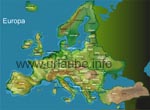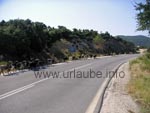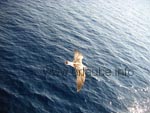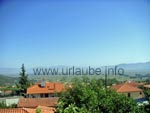|
|
|
General information of east Macedonia
Before we get deep into each of the cities and locations, I first want to give you some general information of Macedonia and Thessaloniki. How the weather is, how hot it is there? How is the best way to get there and with what costs do we have to count? How is the traffic in Greece? Answers to questions that arise before the trip. Geography and climateThe area that refers to my travel report is a zone located in the north of Greece, that is, to be more exact, located in the eastern part of the region of Macedonia. The north is bordered by the Falakró mountains, the south by the Aegean sea, the west by the city Thessaloniki and the east by the region Thrace. The climate is moderated mediterranean, as due to the closeness to the Balkan, the winters are, compared to the other mediterranean climates, rather continental, thus humid and cold. Indeed, it seldom snows at the Aegean coast and the thermometer hardly drops below 10 degrees, as plenty of mountain ranges as the Pangéon- and Lekánis mountains, which peaks reach a height of more than 2200 metres, block the cold air-currents of the Balkan, but in the altitudes of the inland (for example, in the Falakró muountains by Drama) there is so much snowfall that the business of ski pistes is profitable. 
However, the summers are very hot and dry over large periods. Temperatures of 35įC and more are not exeptional during the summer months, but the trade winds make sure that the climate stays bearable despite of the high temperatures. The biggest cities of the region are Thessaloniki, the capital of Macedonia and the second biggest city of Greece (approx. 1 million inhabitants), Kavalla (approx. 70.000 inhabitants), Serres and Drama (both approx. 55.000 inhabitants); the highest altitudes are represented by Chionotripa (Falakró Mountain/ Drama / 2232 metres), the Orvilos (The Rhodope Mountains / Serres / 2212 metres) and the Pageo (Pageo Mountains / Kavalla / 1956 metres). The longest of the area is Evros at the border of Thrace with a total length of 204 kilometres that disembogues in the bay of Thrace. Flora and FaunaEast Macedonia belongs to the most densely afforested regions of Greece. It's flora belongs to the most manifold Europe-wide. Predominantly in the montainous regions that are a major part of Macedonia, coniferous forest predominate the scene, but also deciduous trees as beechs, ash trees, oaks and chestnut trees are not seldom, depending on the microclimate. During the transit, the landscape and the vegetation continuously offer a complete different scene, sometimes mediterranean, steppe or desert, and then a southern scandinavian or middle European embossed scene. Furthermore, there are different kinds of wildflowers as gladiolus, anemones, tulips, narcissuses and violets widely spread that, especially in spring time, put complete grasslands and mountainsides in many colours. In a nature protection area by Drama there are even plants that are not scientifically investigated. 
As the flora, the abundance of species of the east Macedonian fauna is hard to beat. The wolfs and brown bears belong to the most spectacular kinds of animals in the partly far-flunged northern mountain regions of the Falakró mountains, but also in the Elatia forest by Drama, and also red deer, jackals, foxes, wildcats and badgers are native of east Macedonia. Moreover, the region appeals with the large bird populations, from which approximately two thirds are migrant birds that like to remain in the big lakes of the region. Among other things, there are storks, egrets, pelicans and some big kinds of birds of prey, as the imperial eagle and the golden eagle. 
Last but not least, the amphibians and the reptiles are to be mentioned, as beside the turtles, lizards, geckos, salamanders, skorpions and efts, also some kinds of snakes (natters, vipers)do exist, that partly are poisoned and can be really dangerous for the humans. Here, the rule of thumb applies: the bigger the snake, the less dangerous it mostly ist. The really poisoned (horned viper for example) are seldom longer than a metre. Most of the times, their length is with 50 or 75 centimetres far below a metre. Those who are moving by foot through the area should therefore always be cautious and wear sturdy shoes up to the ankles and step strongly so that the snakes notice the vibration and therefore the presence of a human being, what makes them probably escape. Also stone throws into the bushes by passing can avoid the confrontation with the poisoned reptiles. ArrivalThe most cheapest way to get there is by plane. Many times a week, low-cost carriers as Easyjet and others approach the two destination places in the region, Thessaloniki and Kavalla, from many European airports. Those who plan their vacations in time and follow the newest offers in the internet can already fly for little money to Greece. During the bargain flights, indeed the snacks are of steep prices, but the flight time is only about two and a half hours and self-catering is, of course, allowed. Those who prefer the adventuresome travel by car in order to be mobile on the spot, have the possibility to get transferred with the ferry from Venice, Trieste, Brindisi or Bari to Igoumenitsa. The remaining 450 kilometres on the greek mainland up to Thessaloniki are partly extremely curvy and only recommendable for people free from giddiness. But the previous reservation of a rental car is rather recommendable, as only the ferry transit takes 24 hours per way and in the peak season, both ways cost approximately 600 € (the car additionally 100 € or more) per person that, in case of several persons, is far more expensive than the price for the flights and a 14-days car rental. For our travel group we rented a Hyundai Accent in advance that resulted to be technically irreproachable and clean that cost 660 € for 14 days. But a price comparison should definitely be done in any case. The shuttle from the airport in Thessaloniki to the central of the car rental called "VIPís Rent-a-car", that was only a few kilometres away from the airport, ran smoothly after a short search for the conductor, as the two-floor airport building of Thessaloniki is very clearly arranged: departures upstairs, arrivals downstairs. All arriving customers of VIPís, that most probably were previously also in the same plane, were driven together in a van to a branch of VIPís, where, after having cleared the formalities, the rental cars were released. As a matter of course, there are plenty of other car rentals (Sixt, Hertz), but here it is to be said that a booking in time is neccessary, as in the summer time, rented cars are highly demanded. By the way, the cars are released with a mostly empty tank, so that the way straight to the next gas station is not to be avoided. But refueling is in Greece not so expensive as in Germany, as the litre fuel costs approximately only two thirds of the german price. Traffic in GreeceThe only thing that made us taken aback was that the license plates of our car were printed on paper and sticked behind the front and the back window. But after the first kilometres on greek roads, our fear to be stopped by the police due to that rapidly disappeared, as numerous domestic cars are on their way with paper license plates. Once a license number is registered in Greece, it must not neccessarily be adjusted as a tin-plate sign at the bumper. 
The traffic in Greece however, resulted first to be needed to get used to. Motorways like the E90/A2, that is currently extended and includes from Thessaloniki eastern Macedonia with interruptions (country roads), are rare. Also the sand area is welcomed to be used as an additional lane. Motorway stations or gas stations are unknown at the motorways. Indeed, there are separated cut-outs in which merchants offer fruit, vegetables and schnapps, but for refueling, the next locality offside the motorway must be directed. In case of a break down, the breakdown service of the automobile club ELPA will help, that is available under the number 10400. By the way, on the signs, the names of the localities and cities are not only written in greek lettering. Thus it is not a problem to come to grips with it. The average greek country road driver however would have bad problems with the police in the german traffic. Whenever there is the opportunity to overtake, it is strucked with no mercy. In general, the traffic is a very dynamic arrangement on four country roads that is constructed to get fast from A to B. Somehow, the lack of the motorways has to be compensated. Thus, a basic condition is a certain degree of ability to adapt. In order to reduce the rate of accidents, some time ago some exorbitant punishments have been introduced that should contribute to an important slowdown of the traffic. But due to the reason that the police appears relatively seldom, there are still very brave car drivers. But if this unfortunate case occurs to be punished by police men for a regulatory offence, then, for exceeding the velocity by more than 30 kilometres per hour, full 350 € are to be paid. More drastical are the punishments in case of driving while intoxicated. By exceeding 1,1 per mill, one gets really into trouble: 1200 € penalty! The only consolation that remains is that in Greece, the public traffic service and the taxis are very cheap. According to this, it is recommendable to drive carefully on the country roads and always keep an eye on the traffic of the opposite direction. Numerous little adorned remembrance boxes with candles and pictures inside that look similar to miniature chapels, catch immediately someone's eye in the motorways. Indeed, these are positioned there for the most different reasons, but some of them testify, often with pictures, also accidents of the past and correspond to the local wood roods. The traffic is not less dangerous for the pedestrians. Most of the times, the cars have right of way, specially in the cities - even if the traffic lights are green for the pedestrians. To fight for one's right could have here fatal consequences, as also within the city limits, the speed limits appear to be rather a friendly recommendation of speed, no matter if in the city or in the country. But due to the reason that fearmongering is out of place, there is only to say: with a little attention, one gets rapidly used to the greek traffic and will not have bigger problems. Even me, a panic co-driver with acrophobia, who never drives faster than 140 kilometres per hour in german autobahns, I already stopped in the 5th day to maul our highly adopted driver who was continuously driven by his greek mind, with questions like "Say, do you only want to kill yourself or all of us?", when we were again driving on the curvy country roads in the mountains. Well, at least, this question appeared increasingly rarely. 
Back to the index Thessaloniki Copyright: Patrick Wagner, www.tourist-guide.biz |
||